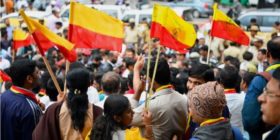Tokyo: The Indian Navy’s ability to carry out amphibious landing, casualty evacuation, humanitarian assistance and long-range surveillance and reconnaissance received a major boost today, with Japan agreeing to sell and transfer technology to India to build the specialised sea-plane, the US-2 produced by ShinMaywa.
A joint statement, issued today in Tokyo after the summit meeting between Prime Minister Narendra Modi and Japanese Prime Minister Shinzo Abe, said, “Both sides directed the Joint Working Group to accelerate progress in the discussions and preparations for a road map for the development of the Indian aircraft industry through US-2 amphibian aircraft cooperation including the transfer of the aircraft and its technology to India.”
In keeping with the Modi government’s policy, these planes will be made in India.
This is the first time since World War-II – that ended seven decades ago – that Japan will be selling military hardware. Following its defeat, Japan imposed an embargo on sale of weapons and military equipment. The agreement is an indication of the closeness between India and Japan. Both nations are actively pursuing each other mainly in the areas of defence and trade to counter the growth of China and its increasingly aggressive behaviour in the region.
The four-engine ShinMaywa aircraft will act as a force multiplier for the Indian Navy. Besides allowing the Indian Navy the capability to quickly insert troops at places where there is no landing strip on shore, the sea planes will be invaluable in the numerous far-flung islands in Andaman and Nicobar and Lakshwadeep. As of now, ground troops are inserted by using the ‘Landing Ship Tank’, which aren’t always effective. The sea planes will allow faster troop insertion of a small number of troops for specialised operations.
India has a 7,516-kilometre long coastline and the Navy had earlier projected a requirement of 15 such sea planes. Shortage of funds and other more pressing requirements like acquiring multi-role helicopters, torpedoes, submarines and ships had forced the government to put the issue on the back-burner.
The US-2 is one of the sturdiest aircraft and can operate in sea state 5 conditions (at wind speed of 30 to 38 kilometres per hour) on the high seas as well as on rivers and lakes. It can carry nearly 30 personnel and 18 tonnes of load and can fly 4,500 km at a stretch






Leave a reply